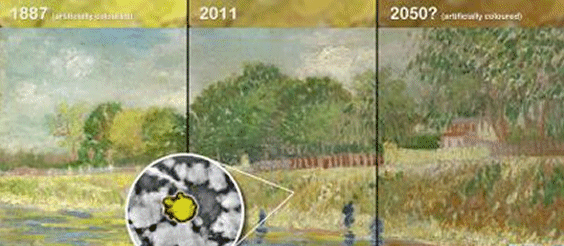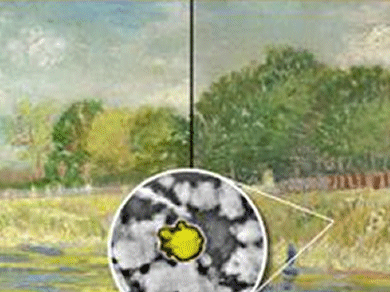Van Gogh’s (1853 – 1890) use of bright colors in his paintings is a major milestone in the history of art: He deliberately chose colors that conveyed mood and emotion, rather than employing them realistically. However, the bright yellows he used, particularly in the famous Sunflowers series, have started to fade.
To discover how and why these colors are slowly turning brown, Koen Janssens, Antwerp University, Belgium, and co-workers have used microscopic X-ray absorption near edge (μ-XANES) and X-ray fluorescence spectrometry (μ-XRF) to study paint tubes from that period and two of van Gogh’s paintings.
Paint from tubes belonging to Flemish Fauvist Rik Wouters (1882 –1913), were artificially aged under a UV-lamp for 500 h. During this time, the paint changed from bright yellow to chocolate brown. X-ray analysis identified the darkening of the top layer as linked to a reduction of the chromium in the chrome yellow from Cr(VI) to Cr(III).
The team also examined samples from affected areas of two van Gogh paintings, View of Arles with Irises (1888) and Bank of the Seine (1887), with μ-XANES and μ-XRF. The results indicate that a similar reduction from Cr(VI) to Cr(III) is likely to have taken place. The presence of Cr(III) correlated to the presence of Ba(sulfate) and/or aluminum silicate compounds, implying that van Gogh’s technique of blending white and yellow paint might catalyze the darkening of his yellow paint.

Image: Photo of the painting “Bank of the River Seine” on display at the van Gogh Museum, divided in three and artificially colored to simulate a possible state in 1887 and 2050. (c) ESRF/Antwerp University/Van Gogh Museum
- Degradation Process of Lead Chromate in Paintings by Vincent van Gogh Studied by Means of Synchrotron X-ray Spectromicroscopy and Related Methods. 1. Artificially Aged Model Samples and 2. Original Paint Layer Samples
L. Monico, G. Van der Snickt, K. Janssens, W. De Nolf, C. Miliani, J. Dik, M. Radepont, E. Hendriks, M. Geldof, M. Cotte,
Anal. Chem. 2011.
https://doi.org/10.1021/ac1025122
Also of Interest
- Research Highlight: Mona Lisa’s Secret
The reason behind Mona Lisa’s enigmatic smile has been exposed as X-ray fluorescence spectroscopy unveils Da Vinci’s sfumato technique




